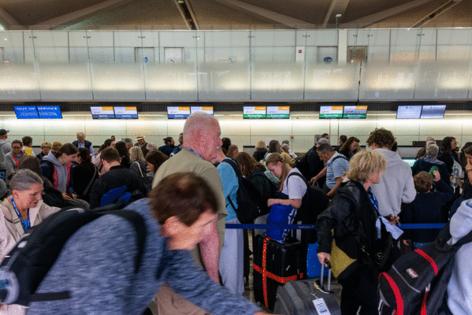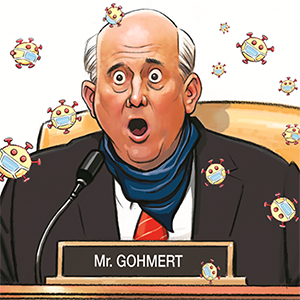Newark Airport Meltdown: What's behind the flight delays? When will they end?
Published in News & Features
For a week and counting, flying in and out of Newark Airport has inflicted misery on travelers. The cancellations and delays have been caused by a cascade of infrastructure failures and staffing issues that have ground air travel to a crawl.
What’s behind it the meltdown and when might it end?
Here’s what you need to know before you fly:
How extensive are the delays out of Newark Airport?
They delays and cancellations have been extensive, Monday, more than 150 flights into and out of Newark were canceled as of midday and nearly 300 were delayed, according to flight tracking website FlightAware.
Inbound flights contending with low cloud cover and ongoing air traffic control issues were delayed as much as 4 hours.
The rainy-day delays capped what’s now become a full week of pain for those traveling through the international airport, with days of hundreds of canceled flights and hours-long delays.
What triggered the problem?
The trouble started April 28, when sources tell the Daily News two unrelated air traffic control systems — the radar coverage of the north Jersey airspace and the telecommunications lines between the controllers and the local airport towers — failed shortly before 2 p.m.
For two hours, Newark was effectively shut down, with no planes in or out.
The systems were restored and flights resumed within three hours, but the outage exposed two weak links in an aging air traffic control infrastructure.
Airplanes approaching or departing from an airport are handled by an air-traffic control system known as “terminal radar approach control” — or TRACON. TRACON controllers are responsible for guiding a pilot’s ascent or descent from an airport, bridging the gap between the local towers controlling planes at the airport, and the controllers tasked with directing planes already at cruising altitude.
Until last year, New York TRACON — located in Nassau County — controlled the skies for all three major NYC airports: Newark, LaGuardia, and JFK. That was changed in July, when the FAA gave control of the north Jersey airspace — and the two-dozen air traffic controllers who were certified on it — to Philadelphia TRACON. The move was an effort to more evenly distribute the workload away from the chronically understaffed Long Island control center.
But despite the reassignment, the radar feeds for the north Jersey airspace controllers rely on are still sent to New York TRACON, a source told The News. From there they must be sent on to Philadelphia — a situation that introduces latency into the system and can cause outages.
A spokesman for the air traffic controller’s union, NATCA, confirmed to The News Monday that last week’s incident had effectively blinded Philadelphia TRACON.
“On Monday, April 28, air traffic controllers in Area C of the Philadelphia TRACON, who are responsible for separating and sequencing aircraft in and out of Newark Airport, temporarily lost radar and communications with the aircraft under their control, unable to see, hear, or talk to them,” read a statement distributed by NATCA spokesman Galen Munroe.
Did air traffic controllers walk off their jobs?
Though traffic resumed quickly last Monday, delays soon followed due to another on the cascading series of problems: a shortage of air traffic controllers in Philadelphia.
According to the controller’s union, “due to the event, the controllers took absence under the Federal Employees Compensation Act. This program covers all federal employees that are physically injured or experience a traumatic event on the job.”
“The controllers did not ‘walk off the job,'” the statement added, refutating a statement from United Airlines CEO Scott Kirby, who used the phrase last week. Newark is a major hub for United.
Sources told The News that five of the 25 controllers assigned to the Newark airspace took a leave of absence, a 20% reduction in the workforce. The reduced number of controllers has made it difficult for Newark keep flights on schedule, leading to the week of delays, and leading United to pull 10% of their flights from the airport.
Complicating matters even further, scheduled maintenance work has taken one of Newark’s three runways — the North-South facing Runway 4L/22R — out of service until mid-June.
When will the delays end?
It’s not clear.
Newark won’t have three working runways until the summer.
The controllers’ contract allows them take up to 45 days of leave.
And sources say the radar and communication systems are old and could easily fail again.
NATCA, the controllers’ union, said it “supports Department of Transportation Secretary Sean Duffy’s efforts to upgrade and modernize our nation’s air traffic control systems and infrastructure,” but its not yet clear what those upgrades will be or what the timeline is for their installation.
Last Thursday — three days after the outage — Duffy announced he would “supercharge the air traffic controller workforce.” The secretary had announced a 30% increase in the base salary for trainees, as well as a $10,000 one-time bonus for new controllers headed to any of a list of 13 “hard to staff” control facilities.
But as Senate Minority Leader Chuck Schumer, D – N.Y., said Monday that neither New York TRACON nor Philadelphia TRACON made Duffy’s “hard to staff” list.
The Democratic leader made the remarks in a letter to the acting DOT inspector general, Mitch Behm, asking him to dig into the staffing and infrastructural problems surrounding New York metro air traffic control.
©2025 New York Daily News. Visit at nydailynews.com. Distributed by Tribune Content Agency, LLC.







Comments